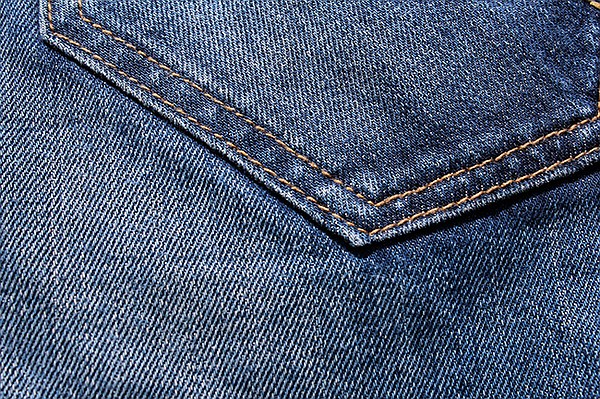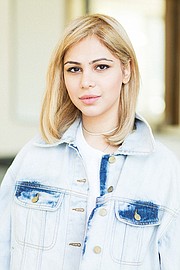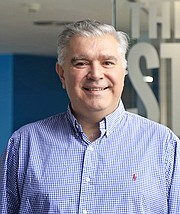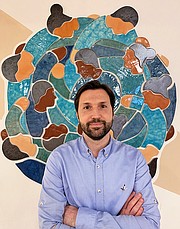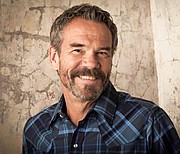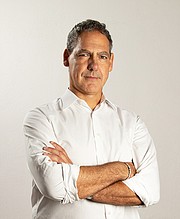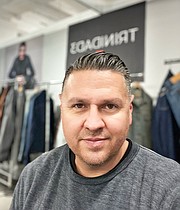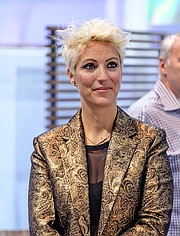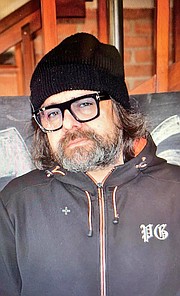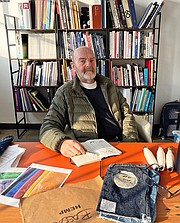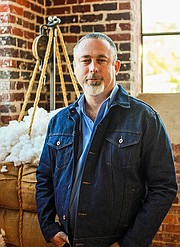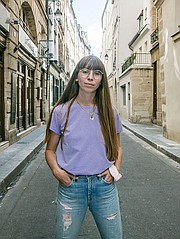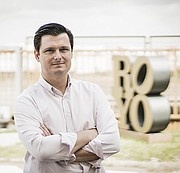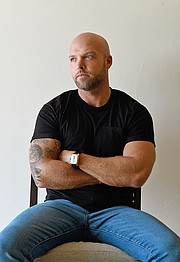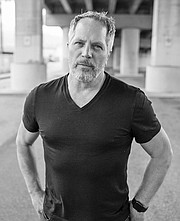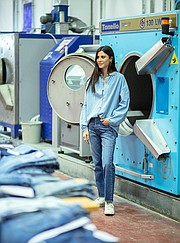INDUSTRY FOCUS: DENIM
Industry Focus: Denim—What advancements and innovations within denim make you hopeful for the future of the industry, and how will these contributions create progress in the category?
As one of the textiles that boasts the deepest roots and richest global history, denim has been an influential component of popular culture and fashion for centuries. Through war and peace, formal events and casual affairs, travel adventures and remaining close to home, the beginning of life and the end, denim has been everywhere. The impact of denim has contributed to the elements that defined the contributions of different generations within music, art, politics and cultural movements. Its role is constantly changing, and its evolution is fascinating.
At the crossroads of another shift in denim culture, now defined by technological advancements and sustainable efforts, California Apparel News asked denim experts: What advancements and innovations within denim make you hopeful for the future of the industry, and how will these contributions create progress in the category?
Beyza Abaykan
Founder and Chief Executive Officer
HMS Washing
HMS—Hand Made Stone—is ecologically groundbreaking on three fronts: water, durability and carbon footprint. Stonewashing can unfortunately consume a large amount of water through its process. We at Baytech [Sustainable Teechnologies] are able to reduce HMS consumption. HMS reduces water use in the washing process by 20 percent. It also does not require any rinsing steps as opposed to three rinsing cycles for pumice. Not only does it reduce water use but also leaves little to no sludge, resulting in cleaner water as the outcome of the process.
HMS is also vastly more durable than pumice, with stones constructed using upcycled pumice and biopolymers, which last 60 to 100 times longer than pumice. This allows businesses to have a stock of stones that last longer and rely less on the supply chain.
With 60 to 100 times more durability, a business’s shipment needs—and therefore its carbon footprint—are decreased by 60 to 100 times that of pumice. Carbon footprint and shipments are reduced, decreasing transportation costs while also being more sustainable.
At Baytech/HMS, we are providing patented eco-friendly stones to garment producers and processors including denim, non-denim and knits for trials all around the world.
Sarah Ahmed
Co-founder and Chief Creative Officer
DL1961
DL1961 is a leader in denim innovation and environmental consciousness that aims to combat the denim industry’s continued greenwashing and lack of transparency when it comes to sustainability practices. Denim manufacturing can be an environmentally harmful process, but each day more and more brands are committing to sustainability and circularity in order to lessen the industry’s impact on the planet for future generations.
Using less than 10 gallons of water for each pair of DL1961 jeans, which are produced at our vertically integrated, self-powered facility, we use botanic fibers, organic and certified cotton, clean dyes, and energy-efficient machinery to preserve resources. Any resource we can preserve or carbon footprint we can reduce, we are committed to finding a way.
The next step of course is to communicate this commitment to the customer. If the customer is not aware that the brands they are investing in are harming the environment through their manufacturing processes, how will they ever know that brands like DL1961 are working to protect it? We must all work together to be innovative and impactful in our sustainability practices to protect the integrity of our business, industry and, ultimately, the environment.
Carlos Arias
Chief Executive Officer
DenimFWD
I am most hopeful about the implementation of technology that allows denim-jeans finishing to be done by eliminating stones, eliminating potassium permanganate and significantly reducing the amount of water used in traditional processing while at the same time achieving beautiful products that are highly replicable in an on-demand environment. I am also excited about the advances in digital tools that allow the elimination of waste in the product-development stage and allow for cost reductions and time savings in this important area.
Our collective efforts to make the denim industry more sustainable will be rewarded by consumers who are demanding a new approach to how we produce their beloved jeans. Technology has advanced to the point where we can make a big difference in reducing the environmental footprint of denim, and I believe that when you know better you do better!
Lemi Arkis
Founder and Partner
Reynas Lable
In the world today, more than 6 billion jeans are produced, and to produce them an intensive cultivation of cotton and substances that have a strong environmental and social impact on everything around us are used. Today, many steps have been taken in the right direction at the production level by companies in the supply chain. Much has been invested in research and the production of new technologies that allow conscious and sustainable production, limiting the use of water and polluting products, and creating new natural fibers that are recycled and biodegradable.
We all need to produce better and exactly to the consumer’s need because overproduction in the fashion industry is still a sore point and creates a problem of disposal and pollution. Even at the level of accessories, great steps have been taken in the direction of conscious production.
At Reynas Lable, our primary preference is the materials obtained from the recycling of tons of consumer waste. In particular, we have detailed studies on felt and fabrics produced with polyester fibers recycled from PET bottles collected from the sea. We also produce PU BIO-Based by reusing plant-fiber waste generated in the agricultural industry. This unique product contains 43 percent sugarcane, hemp and corn, and is OCS certified.
Producing innovation, but in a sustainable and conscientious way, is the only solution for the future of our industry.
Egemen Bilge
Head of Business Innovation
ISKO Denim
The future of denim lies with a fully circular management system. ISKO’s approach to circularity considers a future where no virgin material is needed to produce beautiful, durable and high-performing woven fabrics. To do this, we are removing the reliance on fossil fuels and virgin materials, using only renewable energy plus reusing and recycling materials already in circulation. ISKO keeps pioneering sustainable fashion, most recently developing R-TWO50+—an exclusive yarn-spinning technology that uses a minimum of 50 percent Global Recycled Standard–certified recycled materials, reducing carbon emissions by as much as 45 percent and water usage by as much as 65 percent.
We also continue to push responsible innovation within the industry. One of the key methods in our circularity-system approach is thermochemical postconsumer-textile separation through The Green Machine as our first investment in this technology for poly/cotton-blended textiles. It uses an innovative and ultra-efficient hydrothermal treatment method that decomposes cotton into cellulose powders, enabling the separation of polyester fibers from blended fabrics.
Alberto Candiani
President and Owner
Candiani Denim
The impact of jeans manufacturing has to decrease significantly if we want to keep this industry sustainable—financially and environmentally. That should start with the fiber, with cotton and its farming, adopting regenerative agricultural practices.
The improvements should continue with textiles and manufacturing, with a strong focus on water savings and contamination, smart materials and denim fabrics, and pairs of jeans that can provide smart end-of-life solutions, from recycling to compost.
Tricia Carey
Director Global Business Development
Lenzing
The denim industry thrives on advancements and innovations within resale, indigo application, and collaborations that will lead to a lower environmental impact and social improvements. With the durability and heritage of the denim market, resale platforms keep quality denim in circulation longer. Less production, while satisfying the need for consumers to try new styles, is the way forward and is demonstrated by Boyish’s Consignment Shop and Levi’s Secondhand.
There is a range of innovations with indigo application including our TENCEL Modal with indigo-color technology where we add indigo pigment into the fiber-production process, reducing water and chemical and energy impacts. Looking at indigo from the inside out with fiber rather than yarn from the outside in is a new lens to the way indigo has been applied for decades. We have to work differently.
Finally, the range of industry collaborations will propel the denim industry forward, from the Transformers Foundation as the voice of the denim supply chain to the Ellen MacArthur Foundation’s Jeans Redesign campaign bringing competitors together for a declaration of change. We support circularity collaborations for REFIBRA technology with Accelerating Circularity and The Circle Book as well as brand partnerships like Kings of Indigo, Closed and Triarchy. It is only together that we can achieve more during these evolutionary times.
Brent Crossland
Founder
5Loc Cotton, LLC
Let’s begin with the cotton farm. Prescriptive input farming and the adoption of soil-health improvement practices are changing the perception of cotton and thus denim at the consumer level. The cotton-farming sector is proving that farming can actually be an answer to environmental concerns rather than a problem. In the manufacturing sector, advances in natural indigo and a cleaner indigo-dyeing process are very encouraging. We are also heartened by the new “zero to very little water” practice and reduction in harmful discharge. And, of course, we are making great strides with “end of life” for denim reusing and recycling. These are very important benefits for the consuming public, and we see a great deal to be invigorated about for the future of denim.
Zennure Danisman
Marketing and Washing Manager
ORTA
We envision a denim future beyond a circular economy to a world of infinite possibilities. Collaboration is enabled in every step of the design and production process from the farmer to the designer, the fabric mill to the fashionista. Where eco technology helps is using fewer natural resources while creating more abundance, and where denim leads fashion is in climate action and building a waste-free denim ecosystem that enables a longer, healthier life for us and the planet.
We are always looking at how we are using less to create new products. With every product we create, we push new horizons beyond sustainable, circular and upcycled toward creating regenerative denim that gives back more than it takes. We believe in the innovation of comfortable stretch toward a biodegradable future. Engineered to revolutionize the future of stretch denim in the industry, our Torque fabric family is a groundbreaking comfort stretch story created from biodegradable mono fibers.
We are also focusing on digitalization. ORTA shares LCA—Life Cycle Assessment—data with its consumers for five years through QR codes. We are also sharing the fiber origin of our products via QR codes for the last three collections.
As a next step in digitalization, we launched the industry-first VR denim journey. This journey immerses you in a 3D world of travel, stories and fabric possibilities in a gaming, zenfulness experience that takes you on a sensory emotional scenic tour of ORTA’s origins and earth-derived fabric-and-dye inspirations.
That’s why we like to say, “Welcome to the metadenimverse of ORTA.” The idea that you are looking at the metaverse is both physical and virtual, and denim has a role in it. You can experience your denim in real life with the physical garments, and you can experience your denim in the virtual world with our VR journey.
Alberto de Conti
Head of Marketing and Fashion Division
Rudolf Group
From the perspective of the manufacturer of chemical auxiliaries for denim and textiles at large, three areas definitely make us hopeful for the future of the industry. Those areas are critical to the identification and adoption of chemistry that can be used as ingredients during true circular design.
The first is regarding auxiliaries manufactured from bio-carbon from either vegetal sources or organic waste. This is where the chemical industry pushes the boundaries of R&D and introduces product propositions from natural sources that do not compete with human and/or animal nutrition. Particularly relevant are those solutions made out of natural waste that is a by-product of human food and animal feed. One example at Rudolf is Ruco-Dry Bio CGR, delivering water repellency for textiles from vegetal waste.
Additionally, regarding auxiliaries manufactured through chemical recycling, another progressive horizon in textile chemistry is the depolymerization of plastic waste for the synthesis of other molecules that can be used for a greener and more sustainable world. Rudolf has renewed its genuine commitment to the environment through the launch of the Cycle-Logic brand and product family. Cycle-Logic captures tremendous technical innovation and pioneers a new path— the upcycling of post-consumer, disposable and nonreturnable plastics such as PET plastic bottles into valuable textile chemistry.
Finally, in denim-finishing auxiliaries from renewable resources, due to the increasing cost—and soon, unavailability—of crude oil, it is very urgent for all players in the textile supply chain to start thinking of renewable raw materials that are alternatives to the petrochemicals currently used. Rudolf has shown the way by introducing the Offuel product series, a progressive array of chemical auxiliaries for denim finishing consisting, by at least 90 percent, of alternatives to crude oil and/or components based on recycled materials.
Ebru Debbag
Executive Director Sales and Marketing
Soorty
Denim is a social connector, global storyteller and mirror of contemporary culture enhanced with technology, scientific progress, beauty and an icon of hope for a better future.
Advancements that are becoming common practices include supply-chain integration, unexpected collaborations, recycling and reusing waste, extracting fewer natural resources with advanced water-consumption-elimination technologies, and regeneration at the fiber stage. The business model is changing to be service oriented with consumers becoming part of the supply chain. Sustainable collections are being replaced by mindsets.
Soorty defines a more meaningful business by using science-based targets as well as placing human needs at the core such as our SOCI organic cotton, Zero Stone, Laser Art finishing, education through Future Possibilities online and Space-D hub in New York City, Seasonless collections, and the first digital denim garment developed with The Fabricant four years ago. Life-cycle analysis helps redefine the design stage. The farm-to-closet path where we define problems leads to new advancements and solutions. In the near future, we will see progress at scale becoming the norm.
Anatt Finkler
Creative Director
Global Denim
First off, I think the future should be circular, and it’s all about recirculating materials back into the supply chain. For this, I am most hopeful for all recycling techniques and creating denim with recycled-content material. This initiative is being carried on by mills today and on a larger scale with companies that are getting to recycle all kinds of textiles and fiber, turning them back into yarn, which is a bright light at the end of the tunnel not only for denim but for fashion in general.
The use of digital tools like virtual showrooms and 3D modeling, with software to visualize how materials act, move and react, is and will continue to allow avoiding sample waste, reducing unwanted inventory and speeding production.
In order to succeed and thrive as an industry, we need to first be mindful of the resources we use, so I’m hopeful that the latest advances in technologies for finishing and dyeing are allowing us to save water, energy, use cleaner chemicals and avoid much waste, ensuring the future of the industry and its ability to continue to grow.
Trinidad Garcia III
Founder
Trinidad3 Jeans
The room for denim advancement is the human element. It starts at the farm level with connecting cotton farmers with developers and designers and ultimately with the consumer. Keeping transparency open and the carbon footprint low is the result of this connection. Advancements in laundry technology such as lasers and ozone washes are saving critical water and creating safer environments for the worker.
The ability to make a positive impact on people’s lives through denim is what I’m most hopeful about. This year we are expanding our Adaptive-jean program, releasing a women’s collection and developing a streetwear capsule to show creativity and inspire the veteran and fashion communities. [We’re] getting back to work and producing jeans here in the United States responsibly!
Lucie Germser
Founder of SPHYNX
Founder of The Women in Denim
For me, the most important innovation is not about the fabric itself but more about those who make it.
With The Women in Denim we are raising awareness about female workers’ living wages. This is the main theme of our next talk, which will take place during the next Bluezone international denim trade show. You will discover that paying your employees better can bring many more benefits than you expected. We, people from the denim industry, all know that this is one of the most important things that has to be changed. Improved. Innovated. And we are working hard on it. Step by step, things will change. After this huge sustainability race, The Women in Denim is expecting denim professionals to consider this massive fact, and we can’t wait to see the factory that will proudly announce, “We now pay our workers decently.”
Paolo Gnutti
Chief Executive Officer
PG
Our duty and task is to offer, to the market and consequently to the final consumer, an increasingly ethical product, where sustainability is not just a word but a natural, conscientious process.
For many years now we have been investing in innovation in order to drastically reduce the waste in our supply chain and to reuse them in production.
Today, our collection is more than 80 percent recycled, and we are investing many resources in the study and development of biotechnological indigo, the new method that is based on the creation of bacteria that replicate the synthesis of the color indigo. It will be a necessary step toward a more ethical product.
Adriano Goldschmied
Founder
House of Gold
Recently we’ve had incredible acceleration in the speed of innovation and new technologies. COVID forced the industry to go even faster. Climate change does not give discounts. The urgency of radical change to bring the textile and apparel business to no impact is clear.
The Ellen McArthur Foundation’s Jean Redesign guide has a dramatic impact on improvements that designers can bring about but also has a lot of influence in the industry. Circularity is the subject of these times. The jean has to be more durable, biodegradable and ready for recycling. With fibers, there is a revolution in progress. Cotton will give way to cellulosic fibers like Tencel and natural fibers like hemp.
Indigo is a very critical issue. Chemical indigo products from oil are toxic. The future will be in biotechnology to produce indigo with the fermentation of sugar cane. Huue, a startup in San Francisco, is leading the research in this direction.
Sip-Italy, an Italian machines manufacturer, is changing an industry that has been basically the same for 150 years. It is about automation, robots and artificial intelligence.
In laundry, a lot of progress such as laser, nanotechnology, water recycling and ozone are changing a very dirty industry. A good example is Wiser Wash, which uses no stones and very little chemicals and water.
Digitalization is a real change for good. COVID made this an obligation. The future is digital fabric sourcing, digital design, digital samples and digital showrooms. We will produce only what is sold. In traceability, blockchain will make it possible. We are able to control the entire process starting from the farms all the way through the processes up to the time the goods are in the store.
Going local will bring production closer to the consumer, saving CO2 emissions and giving work and potential to local industry.
Juan Carlos Gordillo
Denim Designer
Fortunately there are real advances in the denim industry. One of these important advances in research and the creation of denim fabric is the Dry Indigo process by Tejidos Royo. This process is a revolution in the denim scene because it provides 65 percent water savings in the process and is 100 percent biodegradable. It received the European Business Award for the Environment (EBAE) 2020–2021 for turning denim fabric into a 100 percent ecological product.
This innovation gives me hope because it is developed by a company that also believes in transparency. There is no such thing as sustainable fashion, but there are, more or less, responsible products, a consequence of the work and effort of companies oriented to create an ethical and transparent industry. This is thanks to the people who make companies transparent to create innovations that will change the industry and obviously our world with honesty and not just nice marketing campaigns. I am honored to share that my next capsule collections will be made with Black Dry Indigo by Tejidos Royo.
Ben Kotler
Sales Director
Dear John Denim
With consumer awareness and the rising number of fashion-conscious shoppers, one word comes to mind—sustainability. Becoming part of a community that cares about our environment and human rights is essential to the future of the denim industry. Dear John Denim has been and continues working to further apply newer advancements and practices. For example, our products are made in factories that employ fair-wage practices and provide safe and clean work places for their employees.
New denim fabrics and wash treatments continue to drive the innovations within the denim community. Starting with 2022, we are expanding our sustainability program by using biodegradable fibers such as Tencel Lyocell and REPREVE blends. We are working with our suppliers on securing recycled materials to incorporate into our new fabrications. Advancements such as ozone machine washing are allowing companies to be able to attain a higher level of control over factors such as water, waste, and chemical and recycling management.
We have also been implementing several new wash techniques including ozone machine washing, which allows us to be more eco-friendly by using less water. Solvent-spinning processes have more than a 90 percent recovery of solvents used for washing and dyeing, and our wash-and-dye houses recycle and filter all water used to process our denim and twill garments.
We also ensure that the factories we use to produce our products are 100 percent compliant with international human-rights and wage standards.
As a fashion staple, denim is a leading fashion category. Sustainability and eco-consciousness will contribute to the denim industry’s growth, leading the path to move toward a future with companies that are more transparent and environmentally responsible. Being able to implement these new techniques will slowly start to clean the manufacturing process.
Susan Lee
Founder
Wilder Los Angeles
What is great design? Really great design is very thorough. Really great design is working with the product both on the surface and beneath the surface. It means well designed inside and out. And in the past few years, the definition of a well-designed product has become more complex.
It is an exciting time in the denim industry. We are in a time of shift in global consciousness, a time when we are actively evolving our culture to protect planet Earth. Sustainability has connected us in the denim field to work together for a much bigger goal. We are holding ourselves accountable and raising the platform in the industry to help protect the Earth.
I always say that sustainability is a journey and not an end goal. The denim industry is on this journey together as a collective. We now have more advancements in sustainable materials such as organic and biodegradable cotton, recycled as well as biodegradable polyester, and other more natural cellulose fibers such as hemp and bamboo being incorporated into product. Also, liquid indigos and natural dyes are replacing older powder and chemical dyes for a more-sustainable approach to finishing fabrics. In wash, laser techniques as well as advances in washes that use very little water are making sustainability within denim linear from start to finish.
Again, sustainability is not an end goal. Sustainability is a journey, and it is such a pleasure to be a part of this journey with the denim industry. We are raising the platform in which we make jeans. My hope is that sooner than later we do not have a choice to be sustainable in making jeans. Eventually, there will be no other option. There will only be all-sustainable options.
Steve Maggard
President
Cone Denim
We are excited by the passion and commitment we see within the denim industry for sustainability, transparency and traceability throughout the global supply chain, and Cone Denim is proud to lead the way with many initiatives. We’re focused on a sustainable future. The steps we take, the investments we make, are focused on lowering our impact on the environment and conserving Earth’s natural resources, from the sourcing of raw materials to our manufacturing processes and our final products.
It all starts with fiber—from eco-friendly fibers like hemp and Tencel to responsibly sourced cotton including BCI- and OCS-certified organic cotton. And as the first denim mill to partner with Oritain, the leading product and supply-chain traceability specialists, we use forensic science to verify the origin of our cotton fiber.
Cone is proud to be the first denim mill to have its Science Based Targets and commitment to 1.5 degrees C approved. To further advance our actions, we’ve committed to the UN’s Sustainable Development Goals and are actively participating in the UN Global Compact and CEO Water Mandate. An important part of Cone’s commitment to reducing water usage is installing a new, state-of-the-art, Zero-Liquid Discharge wastewater treatment system with customized ultra filtration and a reverse-osmosis system that recycles 90 percent of the water used during denim manufacturing—saving over 140 million gallons of water per year.
Another step we’re taking toward water conservation is the introduction of our Ozone Flash Finish, which uses 85 percent less water compared to conventional finishing methods. In addition to significant water savings, this eco-efficient ozone technology uses less energy, fewer chemicals and allows us to engineer fabrics with an affinity for laser and eco garment-washing techniques.
Cone Denim is committed to driving sustainable leadership and collaborating with like-minded partners and customers to enact true progress.
Romain Narcy
Board Member of Innovation and Strategy
Blue Matters
On the fabric side, lower-impact indigo-dye techniques appeared, and their usage is spreading not only because environmental concerns gained in momentum but because the cost of water and energy have been skyrocketing starting in 2021. These costs are expected to continuously increase for years to come, so we are hopeful that will lead to a change in our sector.
Artificial eco stones combined with chemicals that are able to replace pumice stones are spreading on the market; therefore, there is hope that toxic indigo sludge will diminish and the export of containers of pumice stones from Turkey to producing countries decreases, reducing the carbon footprint.
More-affordable solutions for water recycling are now available on the market, such as Vatek’s combination of chemical/biologic/MBBR/ultra filtration/reverse osmosis.
On one hand, certain monsters appeared on the market with ultra-fast fashion concepts and questionable production practices. On the other hand, technical solutions in hardware and software appeared that give the denim sector new possibilities to produce, such as on-demand manufacturing and custom-made jeans.
Anne Oudard
Denim Designer
One of my main focuses of the past few years has been to drastically reduce the plastic and fossil fuel–based products in the jeans that I design. Lately I’ve worked with the French brand Patine on stretch jeans made of Candiani’s Coreva denim. It’s made of a natural rubber, plant-based stretch fiber, and this is a huge breakthrough for stretch denim.
I’m also quite fascinated by bio-based indigo pigment. Synthetic indigo is derived from fossil fuel. Unfortunately, natural indigo isn’t really a sustainable solution. I was totally astounded when I found out about lab-grown indigo, produced by sugar-fed bacteria. I am very hopeful that, in a near future, this will become the standard way of making indigo pigment.
Another project that is bringing me a lot of excitement is a research study I am conducting with Ani Wells of Simply Suzette. We are discussing with international denim mills and spinners how to understand the roadblocks and solutions for radical transparency in cotton sourcing. We hear a lot of very inspiring stories, and I can’t wait to share them in the next months. It’s only when you have a clear comprehension of a system that you can bring solutions to improve it.
On a more global scale, I am very happy to see organizations working on legislation to hold brands accountable for their social and environmental impact. The Fashion Act in New York is very inspiring, as is the huge work of Re/Make. In Europe, a few countries have due-diligence laws in place, and a global one is being discussed in the European parliament. This could have a massive impact on fashion brands’ sourcing policies worldwide—for the better!
Ebru Ozaydin
Strategic Marketing Director of Denim, Wovens and Ready-to-Wear
The Lycra Company
Conscious consumerism and environmental stewardship have become significantly important during COVID-19. I am proud of the holistic approach across the denim value chain where we’re interconnected, supporting and learning from each other on technologically advanced, low-impact, resource-saving yet aesthetically pleasing products.
This multistage structure includes becoming fully traceable through blockchain technologies to support farm-to-fashion transparency; using regenerated, recycled, renewable sources to close the loop; implementing 360-degree clean-chemical innovations within fabric production and garment washing to lower water and energy consumption; adhering to a holistic approach with collaborations to offer united solutions for multi-tier concerns for faster implementation; automating source management, smart manufacturing and creating new skill sets; support of institutes and foundations that research and set tangible standards; and certification bodies to measure and monitor progress, providing constant data to avoid greenwashing.
Finally, the emerging trend of the startup brands that offer circular solutions with full transparency and share their impact of ingredients and practices in manufacturing is all about more mindful fashion across all value chains—including the consumer.
Carlo Parisatto
Chief Marketing Officer and Commercial Director
Cadica Group
The last Cadica denim items presented in the new SS23 collection are created with a strong sense of responsibility, with fewer products but richer details and ideas. The whole collection is targeted for unisex and no-gender styles that will reduce waste and samples production. Mixing natural materials, organic fibers, recycled collections and wastes, our mission is to give creative but sustainable and workable suggestions for our fashion customers and partners.
That’s why the Cadica collection can be considered 100 percent circular. Each catalog has the ethical-choice solution with detailed technical information about the companies’ and materials’ certifications.
We have worked with particular attention on the new ethical-choice items: felts coming from the careful recycling of plastic combined with cool screen prints in the total preservation of nature; soluble accessories that disappear in water; and elegance and style emerging from bioplastics and biodegradable resins. We have created 100 percent biodegradable and compostable labels, trying to give them a strong design that can be perfect also for active and tech brands.
Cadica fixed a specific sustainable aim for each SDG of the UN Agenda 2030. We try to suggest to our customers and sector to choose the ethical way, and we give them an idea of the production processes that aim to recycle and reuse their wastes, choosing alternative materials, whether organic and natural or biodegradable.
Change can be possible when all the systems gain access to the circular economy, which is now only available to some because of the high cost of the required investment. If the sector receives real economic and political help it will be able to create new production systems, provide training, and develop strong and extended change. In that way the final products will have lower prices without renouncing the ethical solution.
Francesca Polato
Marketing and Communication Manager
Berto
Denim has always been a cotton-made fabric. Most denim fabrics are principally made of cotton. Nowadays the industry is doing some advancement using fibers different from cotton to produce denim. Natural fibers such as hemp, linen, cellulosic fibers and synthetic fibers sustainably produced are more sustainable than cotton. Using more and more of these fibers will help the industry become more innovative and respectful of people and the environment.
Another very important advancement and innovation is the research and development of recycling technologies. The industry is making great strides in terms of recycling of raw materials, semifinished and finished products. We think that this will contribute a lot to the progress of the category, letting it become more circular and self sustainable.
José Royo
Sales Director and Board Member
Tejidos Royo
Sustainability and circularity are accelerating innovation and imposing themselves in the face of a reality that demands responsibility from us in order to build a more committed denim industry. Factors such as the reduction of resources; consumption of water, energy and chemicals; transparency and traceability throughout the value chain; and the reuse of waste are changing the way denim is produced.
Our motto is to manufacture better with less. We make fabrics with values. Minimizing resources in the production process is key to our business strategy. We use low-impact raw materialssuch asTencel, BCI cotton, Refibra and recycled cotton.
In eco design, we propose products that are oriented toward environmental improvement at all stages, from the conceptual stage to delivery to the customer. This allows us to extend their useful life and increase the subsequent recycling of their components into recycled and recyclable products.
All of our denim production is dyed with our pioneeringDry Indigo and Dry Black technology, which is unique in the world by completely eliminating water in the indigo yarn-dyeing process—sustainable innovation using audited technology.
We use pre- and post-consumer waste to create new fabrics, achieving the same quality as new denim. Our 2030 goal is to have 100 percent of our products contain recycled components. We also recycle all of our industrial waste, which is sorted for reuse, and we make a closed loop of our cotton waste, collaborating with a Valencian company, KM 0, that takes our scraps and carves them to make new yarn for our recycled items.
Betting on new technologies that minimize environmental impact to preserve and improve the health of the planet, guaranteeing labor rights by prioritizing transparency throughout the life cycle, and establishing a circular economy are the value criteria to make the denim industry sustainable.
Miguel Sanchez
Director of the Board
Transformers Foundation
Denim is a fashion pioneer in the development and adoption of progressive materials and technologies. Success is not just the number of new ideas constantly explored by the different supply-chain players but also the combination of efforts and collaborations all along the manufacturing process, from concept design to final garment delivered to market.
This positive collaboration is possible thanks to the fact that the main targets are shared by the different participating tiers, namely: reduction of operational health and safety issues for operators, a decrease in environmental stress, the prevention of classified chemical substances present in final articles at the end-consumer level, a focus on a spiral economy, limiting overproduction, and keeping the “denim spirit” by increasing the options for new styles.
Advancements can be found in materials through adoption of naturally available CEL fibers; mechanically PCW recycled cotton, PET polyester and elastanes; chemical conversion of textile waste into performant man-made cellulosic fibers; and bio-generated or compostable synthetic polymers.
Chemicals should shift towardbiosynthetic products from natural materials, including waste; bio-generated products from naturally available materials; and stopping the use of by-products and residues from different industries through clever-chemistry concepts.
The application of dyes and chemicals of warp and fabric should rely on processes, such as those based infoam application, particularly in the field of fabric finishing and garment processing; compact dyeing and reduction of multi-box application systems; colored MMCF fiber in dope form; and the improved appearance of fabrics through ozone.
In garment processing and finishing, the focus should be on mechanical and energy-based processes with lasers for engraving motifs, plasma for used-look effects, dry enzymes, abrasive materials from natural or biosynthetic origin, and equipment with embedded abrasive panels.
The historical nonconformist character of denim is nowadays represented by high-level technical innovation, the continuous search for better options to minimize biosphere impact and a self-commitment to positive change.
Holly Sanders
Founder and Designer
Angela Denim
Dye technologies are my favorite right now. Natural indigo is hard on resources, and conventional synthetic dyes poison so many people in the world, robbing communities of the opportunities to eat and drink from their rivers. People like Tammy Hsu and Michelle Tzu from Huue are growing indigo dye using E. coli bacteria!
It’s such a cool metaphor for indigo, using a bacterium we think of as icky and using it to grow beautiful indigo dye. This direction, when adopted across the spectrum of denim products, will improve human lives, but on an influential perspective denim represents freedom, and I don’t think it can be a symbol for American freedom if it’s robbing people of their livelihoods. Any advancement in the denim industry helps to solidify denim as a symbol of the American spirit it has always represented. I’m excited to use more life-friendly dye and dye processes for my jeans. The science of denim is so cool, and the opportunity for job growth in this field is something I look forward to.
Mike Simko
Global Marketing Director
Hyosung
It is a dynamic time for denim. Sustainability has made a significant impact on denim innovation, which will continue. Recycled, bio-based and recyclable materials, waterless dyes, and new separation technologies have led to an eco-friendlier denim market.
Circularity is top of mind, and denim brands and mills are following the Ellen MacArthur Foundation’s Jeans Redesign guidelines for recyclable denim. Jeans Redesign’s standards are meant to create jeans that are both more durable and easier to separate and recycle. Denim must be made with a minimum of 98 percent cellulosic material, leaving 2 percent of the content for stretch or synthetic material—a challenge for Jeans Redesign participants as consumers are accustomed to high stretch and comfort.
Brands want denim that stretches by more than 50 percent with a maximum of 5 percent growth. Conventional spandex alone will provide stretch, but the recovery won’t live up to the standard. The typical solution has been to mix polyester with the spandex, creating a dual core that can more effectively bounce back; however, this added polyester content means that synthetic yarns make up 12 to 16 percent of a finished garment, preventing denim from meeting the 98 percent threshold for Jeans Redesign requirements.
Hyosung helps denim brands and mills fit program criteria with creora 3D Max spandex, which delivers a high-performance stretch denim with the required recovery. This yarn technology replaces the synthetic dual core, with a 2 percent spandex content allowing stretch denim to be recycled.
We’ve also helped denim brands finally introduce jeans made with fully recycled materials with our GRS-certified 100 percent recycled creora regen spandex, while our bio-based creora spandex replaces 30 percent of chemicals with a dent-corn product, so when the corn is growing it consumes carbon dioxide, thus reducing greenhouse gases, all documented in SAC’s HIGG index.
Amanda Starling
The Business of Denim Chair
Executive Director, Industry Relations and Career Center
Special Projects Chair
International Manufacturing and Product Development Chair
Fashion Institute of Design & Merchandising
I don’t believe there is any one advancement or innovation in the denim industry that affects the movement forward. It is the overall change within the entire process that is the true advancement. The denim industry has become one of the most forward and innovative industries in today’s fashion world. With a desire to combine creative design with cutting-edge technology we are moving toward a model that is embedded in the everyday business of blue to green. The signature indigo world is moving toward being the leader by using inventive sources that blend with cellulose fibers, making unique yarns into state-of-the-art textiles that bring a new dimension to performance and consumer value.
The continual agricultural changes to enrich the land and brands moving toward forward-thinking construction methods reduce consumption while others use creative developments in the wet and dry processes. With all these changes, we provide an educational focus on post-consumer use and reuse to open the opportunity for change in the denim world.
The true excitement comes from seeing an industry work together toward achieving the same goal—to enrich the developments in all stages of the process from farming, equipment, design, sourcing, production, consumer education and post-consumer use where an entire specialized industry moves together as one unit toward a more circular model—and understanding that not all companies can be complete in all steps but that each one can start with a step and add more steps along the way to eventually change the carbon footprint. The change in the business model is the real key to the future of denim.
Katie Tague
Vice President of Denim Marketing and Sales
Artistic Milliners PVT LTD
I think greenwashing has been and continues to be a big challenge because a few bad apples can end up tarnishing the entire industry’s credibility. It’s vital to act in good faith, but no one should have to make anyone just take it on faith. Instead, show initiatives transparently—take concrete, quantifiable actions that can be traced. I think the advancements using technologies such as blockchain are what make me most hopeful. The fashion value chain is so complex, and the fragmentation of the industry can make things opaque and transparency difficult. Without this ability to back up claims of sustainability or better practices, it’s hard to have confidence that these changes are really happening in our industry. That’s why it’s our ambition to have complete traceability from farm to fashion and why we worked with Retraced. By launching an easy-to-use interface that makes full traceability accessible in our products, we know we are lending further credibility through our Milliner Cotton Initiative.
We really hope to make it the gold standard for our fellow suppliers and brand partners, hopefully helping us all to navigate the sustainability journey with more agility and contribute to the industry being more transparent.
Adam Taubenfligel
Creative Director and Co-founder
Triarchy
Our brands ask us, “How much water are you wearing?” because we want to always remind customers how much water goes into making our day-to-day clothes and then go on to explain how we reduce that water consumption by using technologies that mimic traditional denim-washing techniques in more-responsible ways. Beyond water use, plastics use in fashion has got to go, and Candiani’s Coreva technology is what excites us now. The advancement in being able to substitute plastic for natural rubber and still deliver a comfortable pair of stretch jeans is the future of stretch denim, and it’s an innovation we are proud to be a part of.
Alice Tonello
Marketing, Research and Development
Tonello
At Tonello, to meet the present and future needs of the industry, we have developed the Laundry (R)evolution. This is the sophisticated fruit of a radically new concept in garment-finishing processes. It is, in effect, a revolution, based on three clear words: simple, digital and automatic.
Simple, thanks to just two technologies—THE Laser and the All-in-One System—we can manage the entire finishing cycle both efficiently and flexibly, reducing waste and optimizing resources.
Digital, thanks to Metro, the innovative software for managing and operating the entire laundry, optimizing the processes, and ensuring unparalleled transparency, traceability and flexibility.
Automatic, because everything is done with a few machines, which minimizes manual labor and therefore error, ensuring efficiency and safety at the highest levels.
The result is a garment treated responsibly and with consumption reduced to a minimum, since the combination of the various technologies that are part of Laundry (R) evolution allows for maximum optimization of process times and use of resources. What is more, the reduction, or even the discontinuing, of the use of hazardous chemicals is a decisive step toward an all-around wholesomeness of the industry.
What makes us hopeful for the future of the industry also comes through technological innovations that totally overturn the beliefs we have had up until now. One example is O-Zone, our new static cabinet developed in collaboration with Candiani Denim that, using only ozone, allows us to obtain unique and customizable aesthetic effects such as localized discolorations and lightenings through an innovative, sustainable, responsible process.
With O-Zone, we opened the path to a new way ozone can be applied. In fact, it allows us to get completely new and sustainable washing effects and discolorations, representing a huge evolution in denim treatment.
Jason Trotzuk
President and Creative Director
Fidelity Design House Ltd.
There have been many advancements and innovations throughout the last 20 years in denim, primarily in the advancement and technology of secondary yarns and the contents of denim, allowing performance and comfort in the wearing experience. I have devoted my professional career and design expertise in the denim industry for over the last 25 years and have seen great advancements in the wearability, sustainability and relevance of denim. We have seen the addition of secondary yarns such as Tencel, polyester and other branded and non-branded stretch components to enhance the denim-wear experience. Most recently, denim has now taken on a whole new chapter, leading the way in advancements in waterless, reusable, recycled and sustainable components and practices that keep denim relevant and true to its origin and roots as the fabric and voice of the people for generation after generation.
With all the change in fashion over the last 70 years, blue jeans have remained an icon, and it is impossible not to recognize and appreciate and pay homage to the legacy that is denim. The advancements in fabric over the last 20 years and the technological, environmental advancements have kept blue jeans relevant and true to its origins as a generational compass. Personally, the most exciting thing to see is this new generation being introduced to denim in ways that revive the old standards and early traditions of denim and authenticity and the sourcing from thrift shop and recycled, reused and renewed.
I love denim and designing denim. It has never lied to me and has always been true to its origins and continues to be the guiding light and fabric of our generation and those that came before, and will come in the future. It is the one and only constant clothing that remains cool and credible and the voice of the people that chronicles our life stories.
Aydan Tüzün
Executive Director of Sales and Marketing
Naveena Denim
Recent advancements and innovations within denim are giving a lot of reasons to have hope because the whole industry is having to rethink how jeans are made.
The pandemic shed light on the fragility of today’s fashion industry and the risks it faces in the long term if it does not change. More than ever, consumers are focused on what their products are made of, where they were made and who made them.
We need to move from linear to circular models, and circularity calls for a fundamental change starting with design all the way through a product’s lifecycle.
At Naveena, we continuously invest in technologies that help the industry adopt the circular business model.
Our Holistic Denim line brings together several low-impact materials and processes. The low-impact materials we are using include organic or post-consumer waste (PCW) cotton, Tencel, CiCLO or Lycra Ecomade. Hemp is also an important sustainable fiber as it grows two to three times faster than cotton, has no need for pesticides and requires 70 percent less water. Additionally, it gives antibacterial properties to the product.
Our Horizon process combines Ecolean and Aqualter dyeing and H2NO finishing and saves 80 percent more water, 50 percent more steam and 50 percent more energy than conventional processes.
Our Self-Fit jeans fit two sizes up and down. They are adaptable to any silhouette with excellent shape retention and recovery. This means fewer product returns, lower restocking expenses and better inventory management for the environment. It also means lower carbon emissions from transportation and more-durable, long-wear garments.
Dualistic fabrics provide comfortable and long-lasting garments with easy mechanical stretch, very low bagging and sagging, good dry wicking, a natural aesthetic and hand feel with minimal shine on the fabric surface, and very low fabric shrinkage leading to reduced fabric consumption per garment.
Vivian Wang
Managing Director
Kingpins Show
Kingpins has long been committed to making the denim industry sustainable and responsible.
The UN 2030 Agenda for Sustainable Development and its Sustainable Development Goals was a rallying cry for many in the denim industry, including the Kingpins Show.
Before the COVID-19 pandemic, we began encouraging all of our exhibitors to establish and adopt standards for corporate social responsibility, chemical usage and the environment. We were pleased to see that many denim companies shared our commitment and had set their own 2030 sustainability goals. They had already begun to work on elevating their factories and their products with a focus on sustainability initiatives such as saving water, waste and energy and getting their factories certified.
As we emerge from the pandemic and prepare to return to hosting in-person trade shows, we see that many in the industry continue to pursue these ambitious sustainability goals. These efforts will help the industry continue to shed its reputation as one of the most chemically intensive industries on earth. Through new innovations and new technologies, denim makers are proving that this can be a responsible industry that continues to strive to develop best practices for people and planet.
Central to this is a commitment to transparency—from sharing data to educating consumers to exchanging experiences both good and bad throughout the supply chain.
I am encouraged by the work I see many in the denim community doing, and it gives me so much hope that together we can provide a better future for the next generation.
Ani Wells
Founder and Director
Simply Suzette
I am in full belief that the denim industry is constantly improving by making machinery more efficient, or innovating traceable processes and materials that reduce our pollution and carbon footprint. But, the most exciting advancement that makes me most hopeful for the industry’s future is holistic thinking. It might not be a bright new shiny machine, but with a holistic approach to creating denim with a low environmental impact and positive social impact I believe we will start to see everyone in the supply chain pushing from all sides to create a fair and just industry.
A more tangible innovation that makes me excited for the future is the digitized product-development process. I think 3D design can play a significant role in mitigating textile waste—from 3D design through sampling all the way to publishing a 3D prototype to gauge consumer interest, launch preorders and get consumer feedback. There is so much you can do to avoid creating products that end up wasted. 3D denim design, specifically, is becoming ultra realistic, which makes me so hopeful!
